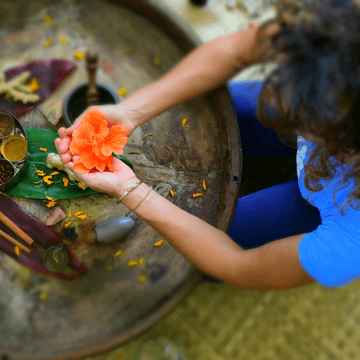Ayurveda – What is it and how does it work? Introduction to Vata, Pitta and Kapha doshas
If you are new to Ayurveda, you may feel a bit lost when you hear mysterious-sounding words like dosha , prakriti or tridosha . This is completely natural – Ayurveda is an ancient knowledge originating from India, and many of its concepts come from Sanskrit. You don’t need to know all of them right away. Just start with a few basic terms that will help you understand the main principles of Ayurveda and start consciously introducing its practices into your daily life.
Ayurveda is not just a system of natural medicine – it is a way of looking at man and the world as a harmonious whole. Body, mind, emotions, spirituality, the rhythm of nature and lifestyle – everything is connected here. The basis of this approach are three energies called doshas , which we find both in nature and in ourselves.
In this article:
Doshas – the basis of the Ayurvedic view of man and health
If you are new to Ayurveda, you may feel a bit lost when you hear mysterious-sounding words like dosha , prakriti or tridosha . This is completely natural – Ayurveda is an ancient knowledge originating from India, and many of its concepts come from Sanskrit. You don’t need to know all of them right away. Just start with a few basic terms that will help you understand the main principles of Ayurveda and start consciously introducing its practices into your daily life.
Ayurveda is not just a system of natural medicine – it is a way of looking at man and the world as a harmonious whole. Body, mind, emotions, spirituality, the rhythm of nature and lifestyle – everything is connected here. The basis of this approach are three energies called doshas , which we find both in nature and in ourselves.

What are the characteristics of each dosha?
Below you will find a brief description of the three doshas. It is worth remembering that all three energies are present in each of us – but usually one or two of them dominate.
Vata dosha – energy of movement (air + ether)
Vata is the force responsible for movement and communication in the body. Thanks to it, we breathe, speak, move, and transmit nerve impulses. Vata is light, cold, dry, changeable, and subtle – like the air and space from which it originates.
People with a dominant Vata prakriti tend to be slim or tall, light, enthusiastic, creative, but also easily distracted. Their skin and hair are often dry, and their immunity is often weakened. They speak and think quickly, but they can also be erratic and emotionally sensitive. Vata disorders lead to insomnia, anxiety, digestive problems, and joint pain.

Pitta dosha – energy of transformation (fire + water)
Pitta governs the processes of metabolism, digestion, and metabolism. It is the energy of fire, which is responsible for the heat in the body, the digestion of food, clarity of thought, and the ability to make decisions. Pitta is hot, sharp, oily, and intense.
Pitta-prakriti are people of medium build, with warm skin, a sharp mind and a strong appetite. They value order, act efficiently, often in a leadership capacity, but can be prone to perfectionism and irritability. When Pitta is disturbed, inflammation, hyperacidity, skin irritation and emotional outbursts occur.

Kapha dosha – energy of stability (earth + water)
Kapha is the energy that gives the body structure, resistance, and calm. It is heavy, cold, slow, stable, and moist—like the earth soaked in water. It is thanks to Kapha that we have strong bones, firm skin, the ability to regenerate, and emotional stability.
Kapha-prakriti are people with a strong physique, calm temperament, great empathy and patience. They tend to retain water, gain weight and digest slowly. In balance, they are loyal, caring and harmonious, but in a state of imbalance, they can fall into apathy, lethargy and even depression.

Prakriti - Your Ayurvedic Constitution
One of the most important assumptions of Ayurveda is that each person has a unique energy constitution , formed at the moment of conception. This is prakriti – the individual proportion of doshas, which influences our appearance, temperament, abilities, immunity and health predispositions.
Knowing your prakriti, you can choose a lifestyle, diet, beauty rituals and physical activity that help maintain balance – and therefore health and well-being.
Ayurveda distinguishes 7 types of constitution:
-
Monodosha : Vata, Pitta, Kapha – when one dosha clearly dominates
Two-dosha (dvandva) : Vata-Pitta, Pitta-Kapha, Vata-Kapha – when two doshas dominate in similar proportions
Balanced (sama prakriti) – when all three doshas are in balance (rare)
Ayurveda begins with knowing yourself. Every answer you seek is already within you.
What dosha dominates you?
Start observing yourself with tenderness and curiosity: how do you react to cold and heat? How do you sleep, digest, and emotions? What are your body and mind characteristics?
You may already have an intuition about which dosha is most active in you. And if you want to be sure, we will soon be posting an Ayurvedic quiz on the blog that will help you discover your prakriti type and plan the first steps towards better well-being and inner balance.
